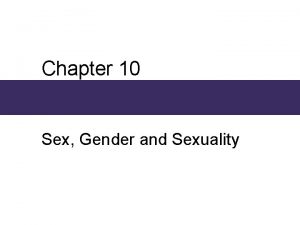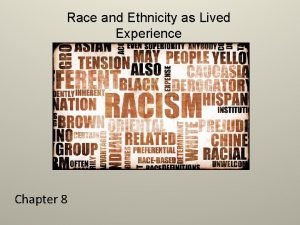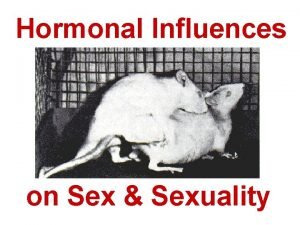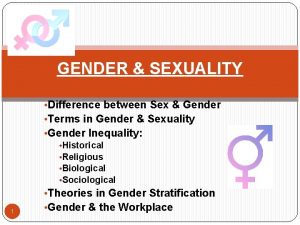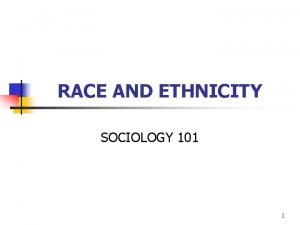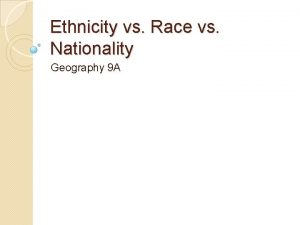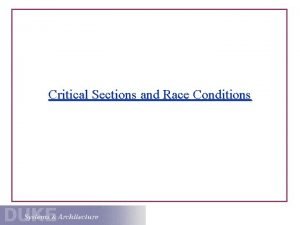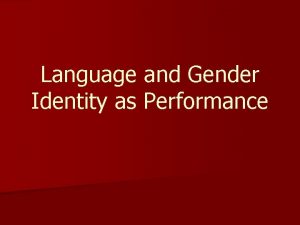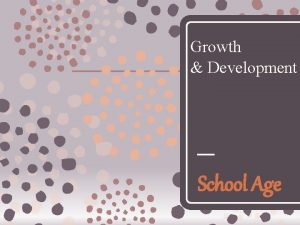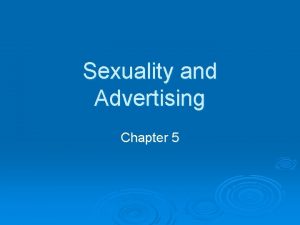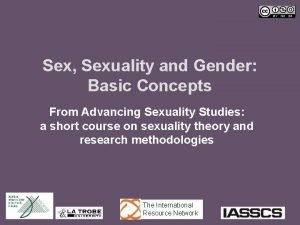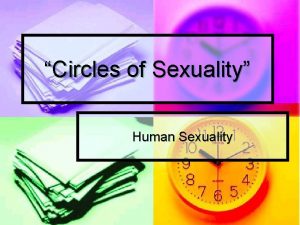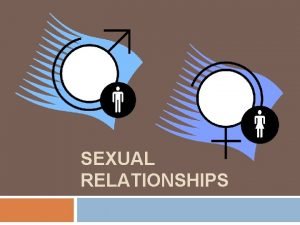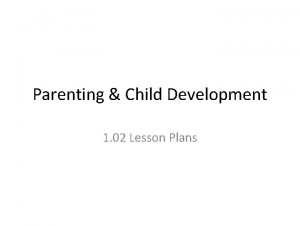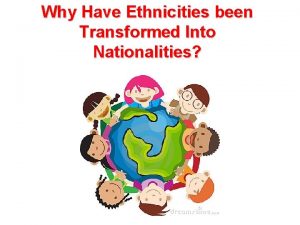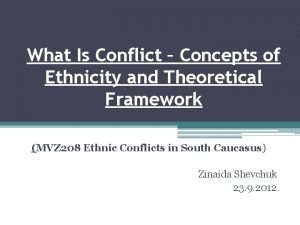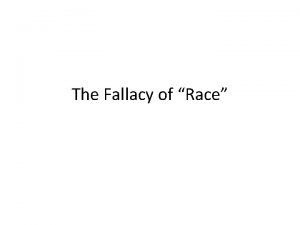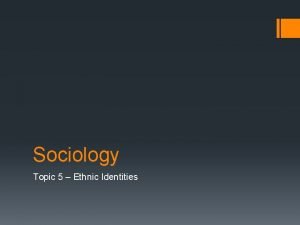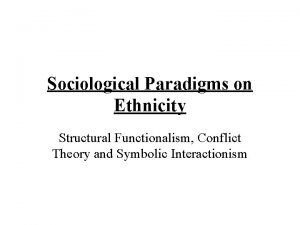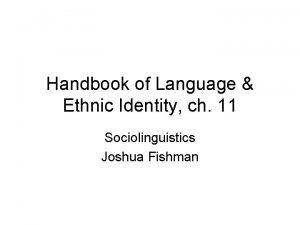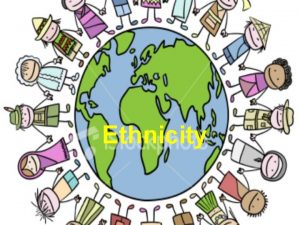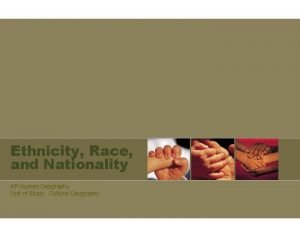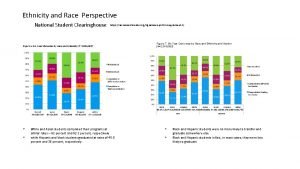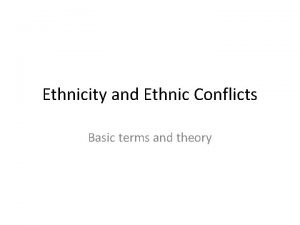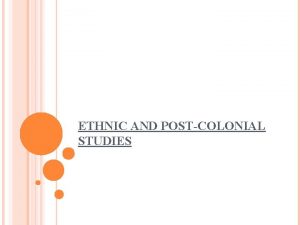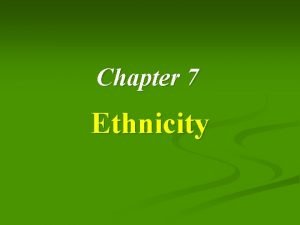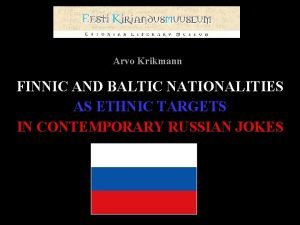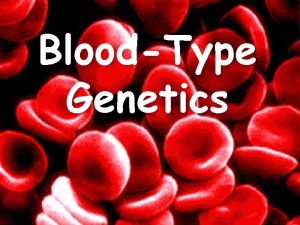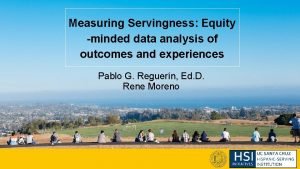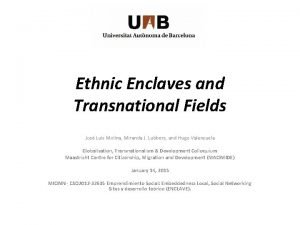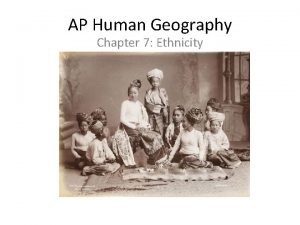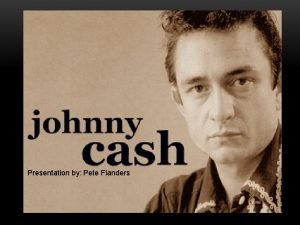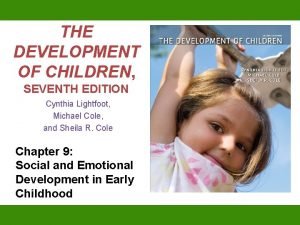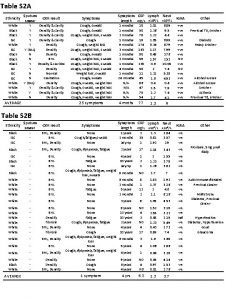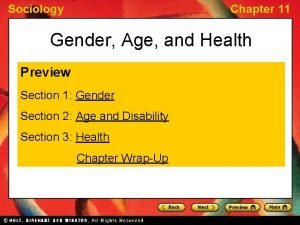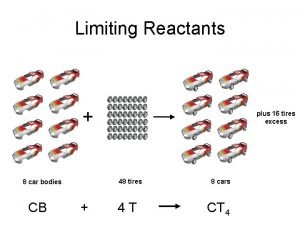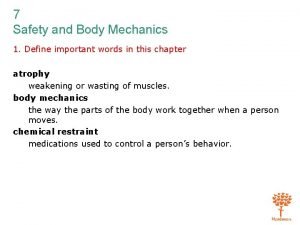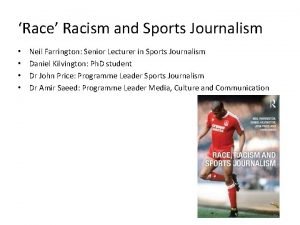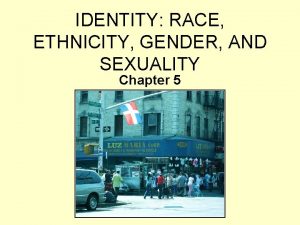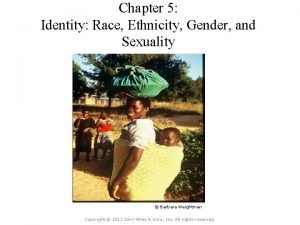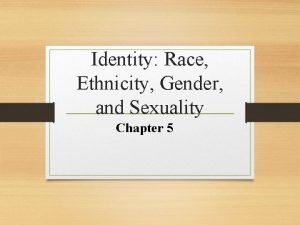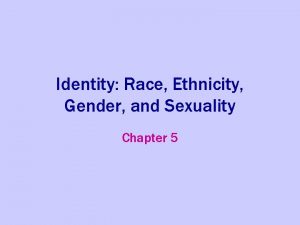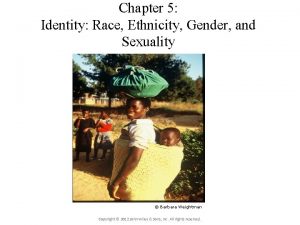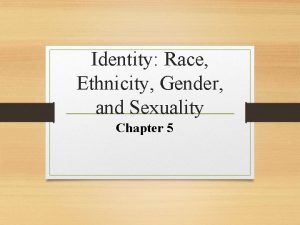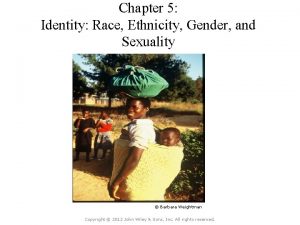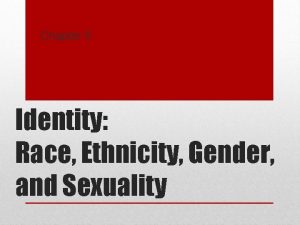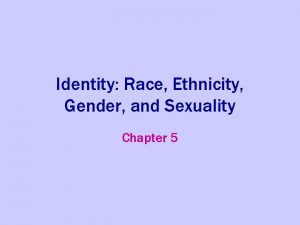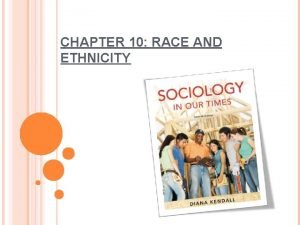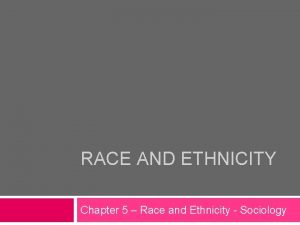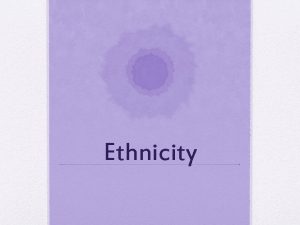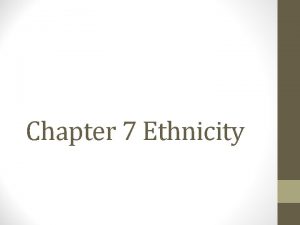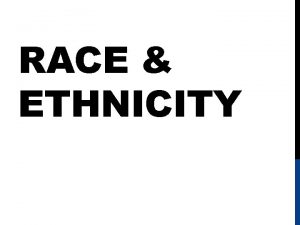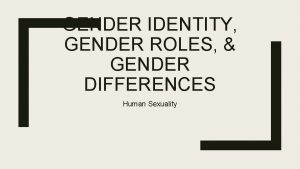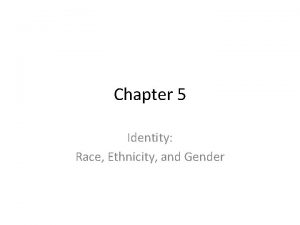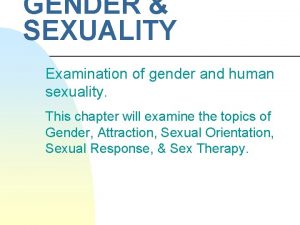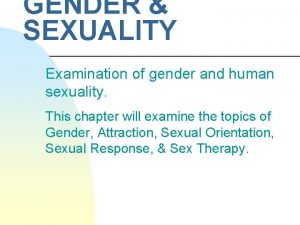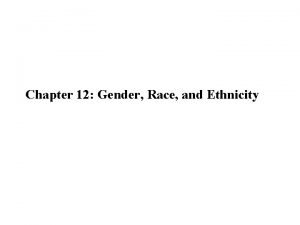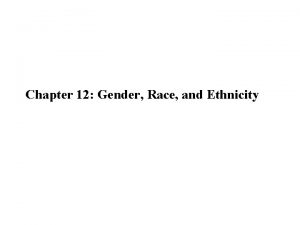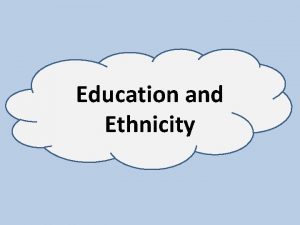Identity Race Ethnicity Gender and Sexuality Chapter 5





























































- Slides: 61

Identity: Race, Ethnicity, Gender, and Sexuality Chapter 5

What is Identity and How are Identities Constructed?

Identity • Identity – “how we make sense of ourselves” – Rose • How do we establish identities? - we construct our identities through experiences, emotions connections, and rejections. - An identity is a snapshot of who we are at a point in time - Identities are fluid, constantly changing, shifting, becoming. - Identities vary across scales, and affect each other across scales. - Identities are also constructed by identifying against (defining the other and then defining ourselves as “not that. ”)

Cultural Identity: Race and Ethnicity • Culture groups – Few or many characteristics (language, religion, race, food, etc. ) – Subculture • Races – Single species – Secondary biological characteristics • Ethnic groups – Ethnocentrism

Gender – “a culture’s assumptions about the differences between men and women: their ‘characters, ’ the roles they play in society, what they represent. ” - Domosh and Seager

What race are these guys?

Race – a categorization of humans based on skin color and other physical characteristics. Racial categories are social and political constructions because they are based on ideas that some biological differences are more important than others.

On Racism and Colonialism “Colonial racism was a major element in that conception of ‘Empire’ which attempted to weld dynastic legitimacy and national community. It did so by generalizing a principle of innate, inherited superiority on which its own domestic position was (however shakily) based on the vastness of overseas possessions, covertly (or not so covertly) conveying the idea that if, say, English lords were naturally superior to other Englishmen, no matter: these other Englishmen were no less superior to the subjected natives. ” - Benedict Anderson

Race…. • Does not exist on a scientific level, despite influence of the idea. • Biological variation is real; the order we impose on this variation by using the concept of race is not. Race is a product of the human mind, not of nature. • For example Bergmann’s Rule – people are naturally more slender in warmer areas and heavier in cooler zones

Race is…… • Based on a three category system developed in Europe in the 18 th century: caucasians, mongoloids, and blacks. • The truth is that there is very little fundamental genetic variety between humans and no way to tell where one category stops and another begins. Race is literally skin deep. There has not been enough time for much genetic variation. We do not have distinct “races” or “subspecies. ”

• Racial Categories are typically imposed on people through: – Residential segregation – Racialized divisions of labor – Racial categories defined by governments

Population in the U. S. by Race, 2000 In 2000, the U. S. Census Bureau allowed Americans to categorize themselves as one race or more than one race.

African Americans in the U. S. Fig. 7 -1: The highest percentages of African Americans are in the rural South and in northern cities.

Hispanic Americans in the U. S. Fig. 7 -2: The highest percentages of Hispanic Americans are in the southwest and in northern cities.

Asian Americans in the U. S. Fig. 7 -3: The highest percentages of Asian Americans are in Hawaii and California.

Native Americans in the U. S. Fig. 7 -4: The highest percentages of Native Americans are in parts of the plains, the southwest, and Alaska.

Estimated Percentage of U. S. Population by Race and Ethnicity until 2050 In 2000, the U. S. Census Bureau calculated race and Hispanic origin separately. Estimates are that by 2050, the “White, non. Hispanic population will no longer be the majority.

Residential Segregation • The “degree to which two or more groups live separately from one another, in different parts of the urban environment. ” – Massey and Denton

Highest Rate of Residential Segregation for African Americans: Milwaukee, Wisconsin

Lowest Rate of Residential Segregation for Hispanics/Latinos: Baltimore for Asians/Pacific Islanders: Baltimore, Maryland

Identities in Neighborhoods change over time: Invasion and Succession: new immigrants to a city often move to areas occupied by older immigrant groups.

Race in the U. S. • Still the most common way people identify themselves, despite its problems. • The basis for much segregation - ethnic neighborhoods - housing covenants • Census forms highlight the problems of defining race. For example, census data was misused by the government WWII to inter Japanese. Protest the census by filling in “human” under OTHER category?

Race in the U. S. Genetic mixing is so common and complete that most geographers dismiss race as a category since it can not be clearly tied to place. • Rosa Parks Japan Town, San Francisco, 1910 Dogs Used to Control Protestors, 1957

Sense of Place and Ethnicity

Sense of Place • We infuse places with meaning and feeling, with memories and emotions. • Our sense of place becomes part of our identity and our identity affects the ways we define and experience place.

What is ethnicity? How is it different than race? 1. identity with a group of people who share the cultural traditions of a particular homeland or hearth (PLACE). Thus: customs, cultural characteristics, language, common history, homeland, etc. . . 2. a socially created system of rules about who belongs and who does not belong to a particular group based on actual or perceived commonality of origin, race, culture. This notion is clearly tied to place. Armenian Puerto Rican Turkish Mongolian Thai Japanese Chinese

How do different places (eg. Switzerland vs. New Glarus, Wisconsin) create different identities (Swiss vs. Swiss American)?

How does a place change when the people who live there change? Today, Mexicali’s Chinatown has few Chinese Residents, but continues to be an important place for the region’s Chinese population.

Ethnicities in Los Angeles Fig. 7 -6: Hispanic, white, African American, and Asian areas in and around Los Angeles.

Ethnicities in Chicago Fig. 7 -5: African Americans, Hispanic Americans, Asian Americans, and European Americans are clustered in different areas of the city.

Identity and Space • Space – “social relations stretched out” • Place – “particular articulations of those social relations as they have come together, over time, in that particular location. ” – Massey and Jess • When people make places, they do so in the context of surrounding social relationships.

Sexuality and Space Where people with a shared identity cluster, how do they create a space for themselves?

Sexuality and Space • What theories explain and inform our understanding of sexuality and space? • Queer Theory – focuses on political engagement of “queers” with the “heteronormative. ”

Power Relationships

Power Relationships • Power Relationships – assumptions and structures about who is in control, who has power over others. How are power relationships reflected in cultural landscapes (the visible human imprint on the landscape)?

Through power relationships, People create places where they limit the access of other peoples. Belfast, Northern Ireland

How do Power Relationships factor into How People are Counted? The U. S. Census undercounts: - minority populations - the homeless The Gross National Income (GNI) does not count: - unpaid work of women in the household - work done by rural women in poorer countries

Informal Economy – private, often home-based activities such as tailoring, beer brewing, food preparation, or vegetable gardening.

Women in Subsaharan Africa - populate much of the rural areas, as men migrate to cities for work. - produce 70% of the region’s food. - only a small percentage of women have legal title to their land.

-Dowry Deaths in India - murders of brides (often by burning) when a dispute arises over a dowry. Difficult to “legislate away” the power relationships that lead to dowry deaths female infanticide is also tied to the disempowerment of women

Ethnic Groups in Los Angeles - barrioization – when the population of a neighborhood changes over largely to Hispanics. - cultural landscapes change to reflect changing populations. - strife is usually tied to economic change.

Nationalism

Nationalities and States • Nationality - legally it is a term encompassing all the citizens of a state, but most definitions refer now to an identity with a group of people who generally occupy a specific territory and bound together by a sense of unity arising from shared ethnicity, customs, belief, or legal status. Such unity rarely exists today within a state. • State - a politically organized territory that is administered by a sovereign government

Nationalism • Helps create national unity • Can be very dangerous • Can breed intolerance of difference and Others

Ethnicities into Nationalities • Rise of nationalities – Nation-states – Nationalism • Multinational states – Former Soviet Union – Russia – Turmoil in the Caucasus • Revival of ethnic identity – Ethnicity and communism – Rebirth of nationalism in Eastern Europe

Republics of the Soviet Union Fig. 7 -11: The Soviet Union consisted of 15 republics that included the country’s largest ethnic groups. These all became independent countries in the early 1990 s.

Ethnic Groups in Russia Fig. 7 -12: Russia officially recognizes 39 ethnic groups, or nationalities, which are concentrated in western and southern portions of the country.

Ethnicities in the Caucasus Fig. 7 -13: The Caucasus region is extremely diverse ethnically. Ethnic groups are spread across several national boundaries.

Clashes of Ethnicities • Ethnic competition to dominate nationality – Ethnic competition in the Horn of Africa – Ethnic competition in Lebanon • Dividing ethnicities among more than one state – Dividing ethnicities in South Asia – Dividing Sri Lanka among ethnicities

Ethnicity in the Horn of Africa Fig. 7 -14: There have been numerous interethnic civil conflicts in the countries of the Horn of Africa (including the Sudan, Ethiopia, Eritrea, and Somalia).

Ethnicities in Lebanon Fig. 7 -15: Christians, Sunni Muslims, Shiite Muslims, and Druze are dominant in different areas of the country.

Ethnic Division of South Asia Fig. 7 -16: At independence in 1947, British India was divided into India and Pakistan, resulting in the migration of 17 million people and many killings. In 1971, after a brutal civil war, East Pakistan became the country of Bangladesh.

Jammu and Kashmir Fig. 7 -17: Although its population is mainly Muslim, much of Jammu and Kashmir became part of India in 1947. India and Pakistan have fought two wars over the territory, and there has been a separatist insurgency in the area.

Sinhalese and Tamils in Sri Lanka Fig. 7 -18: The Sinhalese are mainly Buddhist and speak an Indo-European language, while the Tamils are mainly Hindu and speak a Dravidian language.

Ethnic Cleansing • Ethnic cleansing in Yugoslavia – Creation of multi-ethnic Yugoslavia – Destruction of multi-ethnic Yugoslavia • Ethnic cleansing in central Africa

Forced Migrations after World War Two Fig. 7 -19: Territorial changes after World War II resulted in many migrations, especially by Poles, Germans, and Russians.

The Balkans in 1914 Fig. 7 -20: The northern part of the Balkans was part of Austria-Hungary in 1914, while much of the south was part of the Ottoman Empire. The country of Yugoslavia was created after World War I.

Languages in Southeastern Europe Fig. 7 -21: Several new states were created, and boundaries were shifted after World Wars I and II. New state boundaries often coincided with language areas.

Ethnic Regions in Yugoslavia Fig. 7 -22: Yugoslavia’s six republics until 1992 included much ethnic diversity. Brutal ethnic cleansing occurred in Bosnia, Croatia, and Kosovo during the civil wars of the 1990 s.

Ethnic Cleansing in Kosovo Aerial photography helped document the stages of ethnic cleansing in western Kosovo in 1999.

Ethnicities in Africa Fig. 7 -23: The boundaries of African states do not (and cannot) coincide with the thousands of ethnic groups on the continent.
 Chapter 10 sex gender and sexuality
Chapter 10 sex gender and sexuality Chapter 8: race and ethnicity as lived experience
Chapter 8: race and ethnicity as lived experience Sex gender and sexuality
Sex gender and sexuality Umbrella term
Umbrella term Assimilation culture
Assimilation culture Race vs ethnicity vs nationality
Race vs ethnicity vs nationality Difference between reaction turbine and impulse turbine
Difference between reaction turbine and impulse turbine Dam spillway types
Dam spillway types Strategic gender needs and practical gender needs
Strategic gender needs and practical gender needs Data race vs race condition
Data race vs race condition Gender roles and identity
Gender roles and identity Sexual orientation gender identity
Sexual orientation gender identity Gender identity
Gender identity Gender identity tagalog
Gender identity tagalog Pretest: growth, development, and sexuality
Pretest: growth, development, and sexuality Sexuality in advertising
Sexuality in advertising What are the 4 strands of sexuality?
What are the 4 strands of sexuality? It is the awareness, acceptance of comfort one's body.
It is the awareness, acceptance of comfort one's body. Definition of sexuality
Definition of sexuality Definition of sexuality
Definition of sexuality Which illustrates an emotional aspect of teen sexuality?
Which illustrates an emotional aspect of teen sexuality? Peer sexuality support programme
Peer sexuality support programme Base of uterus
Base of uterus Sexuality spectrum
Sexuality spectrum Identity map activity
Identity map activity Stateless nation
Stateless nation Theory of ethnicity
Theory of ethnicity Troian bellisario ethnicity
Troian bellisario ethnicity What is ethnicity
What is ethnicity Functionalism sociology
Functionalism sociology Symbolic ethnicity
Symbolic ethnicity Ethnicity in sociolinguistics
Ethnicity in sociolinguistics Lactose intolerance countries
Lactose intolerance countries Elements of nationalism include all but
Elements of nationalism include all but Ethnicity examples
Ethnicity examples What is ethnicity
What is ethnicity Ethnicity in postcolonialism
Ethnicity in postcolonialism Whats ethnicity mean
Whats ethnicity mean Baltic finnic ethnic group
Baltic finnic ethnic group Taylor swift ethnicity
Taylor swift ethnicity Avian ku ethnicity
Avian ku ethnicity Blood type genetics
Blood type genetics Bitwit ethnicity
Bitwit ethnicity Is hispanic an ethnicity
Is hispanic an ethnicity Servingness
Servingness Luis molina ethnicity
Luis molina ethnicity Tower hamlets ethnicity
Tower hamlets ethnicity Ethnicity
Ethnicity Vivian cash
Vivian cash Nose
Nose Gordon lightfoot ethnicity
Gordon lightfoot ethnicity Isc ethnicity
Isc ethnicity Chapter 11 gender age and health review worksheet answers
Chapter 11 gender age and health review worksheet answers My aurora health care
My aurora health care Limiting and excess reactants race car answers
Limiting and excess reactants race car answers Chapter 7 safety and body mechanics
Chapter 7 safety and body mechanics Itzhak stern
Itzhak stern Schindler's list characters
Schindler's list characters Blues aab
Blues aab Remember
Remember Race racism and sports journalism
Race racism and sports journalism Human history becomes more and more a race
Human history becomes more and more a race
